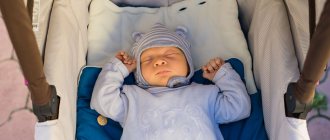It is generally accepted that a good mother walks with her child in a stroller in any weather every day, and preferably twice a day, in the morning and in the evening. However, recent data on the physiology of newborn children refute this well-established rule: a baby does not need walks during the first 40 days of life. Moreover, if you walk with a newborn on the street, this can negatively affect the baby’s well-being and behavior. Why? Anna Fedaka reports.
“When can you walk with a newborn after the maternity hospital?”, “How long can you walk with a newborn in the fall? And in winter? The forums are full of questions from moms who are enthusiastic to do everything right and go for the first (and then second, third) walk with their newborn. It is believed that this is an important contribution to the child’s health, an important routine moment that is more important than any household or mother’s chores, more important than rest.
You need to go outside with your newborn as soon as possible after returning from the maternity hospital, walk and sleep in the air as long as possible - it’s better to spend the entire first year of life outside. And so my mother, convinced of the absolute benefits of walking, spends most of the day walking kilometers with a stroller in the nearest park. She doesn’t have enough time to do household chores, relax on her own, sleep with the child, or do something for herself - after all, she needs to go for a walk.
The purpose of walking with a child in the first months of life is fresh air, we are not talking about impressions yet, the baby walks while sleeping. Where does this desire to make a child sleep on the street come from at all costs? This belief is largely based on research by physiologists that the brain needs oxygen. And then the simple logical chain completes itself: oxygen is on the street, which means you need to walk as much as possible.
In addition, a child sleeps longer and deeper outside - and from this the mother concludes that sleeping in the air is beneficial. But precisely this kind of dream is the main disadvantage of walking with a newborn in the fall, winter, spring - in the cold and cool seasons. This is not a natural sleep for a baby - it is a reaction of the body in response to stress. This is such a paradox.
Why is it important to go for a walk with your child?
- We replenish the need for oxygen. Outdoors, the oxygen content is much higher than in a room. In winter, batteries and heaters additionally dry the air and reduce the content of precious gas.
- Fresh air. The indoor air contains a large number of bacteria, dust, allergens, and household chemicals.
- We stimulate the immune system. Walking is one of the ways to harden the body. The difference between the temperature in the room and outside stimulates the defense mechanisms of the baby's immune system.
- We prevent the development of rickets. Vitamin D is produced in the baby's skin when exposed to ultraviolet light. Even if the day is not entirely clear, a half-hour walk will significantly increase the level of vitamin D and help strengthen the musculoskeletal system.
- Walking is educational. On the street, the baby explores the world around him. The newborn receives new sensations, visual and sound images. An older child finds friends and learns to interact in society.
- Benefit for mom. Physical activity helps to regain shape after childbirth and adjust weight. Walking is an opportunity to find new friends and share parenting secrets. Communication and support among women reduces rates of postpartum depression.
- Interesting pastime. Walking is another opportunity for mother and baby to spend time together.
When can you start walking with your newborn?
It all depends on the time of year when the child was born. If the baby was born in the summer or spring, it is enough to wait 5 - 7 days and begin the first travels. In the cold season you will have to wait for 2 weeks.
You should not go outside if the air temperature drops below minus 10 degrees or rises above 30.
The first walk should not last more than 10 minutes. Place the baby in an envelope and take it in your arms. The first exit can be made on the balcony, especially if taking out the stroller is problematic. Gradually increase the duration of the walk by 5 - 10 minutes, and by 3 months the baby can spend 2 - 3 hours in the air.
The time spent outside is selected individually and depends on the well-being of the little one and weather conditions. On a warm sunny day you can walk all your free time. If the weather is not pleasant, in severe frosts or snowfalls, shorten the walking time.
The newborn spends most of the walk sleeping. Only a couple of months will pass, and the baby will be interested in everything that happens around him. Waking periods will become longer, and brightly colored rattles will need to be attached to the stroller.
Walking with a newborn in autumn
When can I start?
After being discharged from the hospital, give the child 7-10 days to adapt. If the baby feels well, start walking.
What to dress your baby in in the fall?
During the autumn period, parents need to be vigilant, the weather changes quickly. The temperature on the thermometer may be well above zero, but the wind becomes cold.
It is important not to overheat or overcool the baby, all this provokes the development of diseases. Therefore, it is worth walking in good warm weather. In cloudy, humid weather, the duration of the walk should be shortened, but it should not be removed at all.
All clothing for a child should be made from natural, body-friendly materials that allow the skin to breathe. Don't forget about a warm hat if it's cold outside. You definitely need to wear a diaper, even if you go out for a minute, for example, to the store.
Demi-season overalls are ideal for walking. Made from special materials, they retain heat perfectly and can protect the baby from the cold autumn wind.
What to do if it rains?
Modern strollers are very roomy; they can contain everything a baby needs on the street. Various accessories are often included with the stroller: umbrellas, raincoats, mosquito nets.
Long walks in a stroller with a raincoat attached are not the most useful pastime. After all, a raincoat prevents the passage of air to the child, creating a kind of greenhouse effect. But if precipitation catches you unexpectedly on the road, a raincoat will be indispensable.
How long can you walk with your newborn in the fall?
If the little one is well-fed and sleeps peacefully outside, the walk can be extended until the next feeding. The average duration of an autumn walk is 1.5 hours. In good, warm weather, it’s worth taking a walk twice.
A spring walk follows the same rules as an autumn walk. The weather during these seasons is similar and prone to change.
How long should you be outside?
Another question that worries young parents is how long they can walk with their baby in the fall. The first walk in the fall, as experts say, should be 10-15 minutes. Then the amount of time can be significantly increased. So, already in a month it is allowed to walk with the baby for about 40 minutes. Alternatively, if he likes to walk, you can walk as long as he wants.
In addition to the question: how long to walk, the question of when exactly is also important. Here the experts are quite clear in their answers - you should choose a time that is convenient for the mother.
As a rule, such walks fit into the time intervals from 10 to noon or from two to four in the afternoon.
It is worth understanding that such figures are quite arbitrary and may vary depending on the personal preferences of the young mother and her baby.
Summer walks with a newborn
When should you start?
The first trip outside with a healthy baby can be made within 5-7 days after discharge. There is no need to take a long walk with your baby for the first time, even if the weather permits. 10 minutes is enough for your first acquaintance with the street. Gradually increase your walking time with each subsequent outing.
On good summer days, you can allow your child to sleep and play in the yard all day. They bring the fidget home only for eating.
What if it's hot?
If the air temperature exceeds 30 degrees, walking with a newborn is strictly prohibited. The child's thermoregulation mechanisms are not sufficiently developed; the baby can easily overheat. It is better to postpone your walk until the morning or evening hours.
If the thermometer scale reaches 25 degrees Celsius, you need to follow some rules.
- choose light, thin clothes of good quality for your child;
- to avoid overheating, do not swaddle your baby;
- to prevent the baby's back from sweating, the mattress should not contain artificial materials;
- It is worth taking a spare diaper with you so that the baby is not wet;
- do not deny your baby breast milk and water. Remember that breast milk replaces food and drink for the baby.
Possible troubles
Overheat
If simple rules are not followed, long summer trips can result in unpleasant situations for the baby. Often the baby overheats, and the first manifestations are diaper rash and heat rash.
The rash caused by prickly heat causes anxiety to the baby and may interfere with sleep and the general condition of the child. The baby becomes capricious and irritated. With diaper rash, there is pain, loss of appetite and the child’s well-being.
To avoid this, you need to carefully monitor the child’s behavior while walking. When overheated, the baby becomes restless, begins to breathe quickly, and a blush appears on the face. The baby often asks for breastfeeding or water. If you take your temperature at this time, it will be elevated.
Heatstroke, sunstroke
Sunstroke in infants occurs when the baby is under the scorching sun. The child's body is not able to properly regulate temperature, so it overheats very quickly. Heatstroke occurs in babies who have been exposed to elevated temperatures, for example, tightly wrapped in a stroller.
In case of severe overheating, the child’s temperature rises to 38 degrees. The baby’s well-being is disturbed, the child screams or, conversely, becomes lethargic and apathetic. In serious cases, vomiting and loss of consciousness may occur.
In case of heat and sunstroke, you must urgently call an ambulance. Before the doctors arrive, you need to move the child to the shade, undress, and wash his face with water.
Is it possible to exchange walks for sleeping on the balcony?
Often, many mothers are afraid to go out for a walk with their newborn immediately after discharge. And they are interested in the question: is it possible to make adjustments and change walks to sleeping on the balcony. Formally, it seems that there is no difference - it’s still the same air and oxygen.
Doctors are against this replacement option. After all, sleeping on a balcony does not carry the necessary rocking movements, the air flow is reduced, and if the balcony is glazed, then it does not pass through the glazing at all, and the sun hits the baby directly. This brings a lot of problems to newborns - it’s hot and uncomfortable to sleep, and the baby also gets into the habit of falling asleep exclusively in the stroller, which later brings problems - he may give up the crib.
Walking with a newborn in winter
Should you take your newborn outside in winter? Definitely yes. By observing certain conditions, you can protect your baby from hypothermia and stimulate the immune system.
The transforming overalls can be used for both a newborn (as an envelope) and an older baby. Thanks to the zipper system, the envelope turns into warm outerwear.
The transformable winter overalls have a special fur lining sewn into them, which will reliably protect the child from the cold. There are also demi-season and universal overalls.
In universal transformable overalls, the lining is detachable. Mom herself can regulate which version of overalls to dress the baby in, taking into account the weather outside the window. Transformable overalls are very practical and comfortable to wear.
When and how long to walk?
The time and duration of the walk depends on the weather outside and the baby’s well-being. You should be careful if the temperature outside drops below 10 degrees to avoid hypothermia of the child.
How to understand that a child is cold?
If the baby is cold, he begins to move more actively, worry, and cry. The most common way to check whether a child is warm is to feel his nose, but this is not always an adequate indicator. But pale cheeks and redness of the nose, anxiety indicate that the baby is cooling.
You can more reliably determine whether a child is cold at home by undressing and feeling the baby’s legs and arms. Pale, cold palms and feet are a sign that the child is cold.
Before a winter walk, you definitely need to feed your baby. A well-fed baby will be able to maintain his temperature better and sleep more soundly.
Walking when sick
If a child has a cold and suffers from nasal congestion and cough, and the weather is beautiful outside, short walks will benefit the child. Fresh air helps recovery and improves the child’s overall well-being.
If a child has a high fever and severe weakness, walking can aggravate the condition.
In what cases should you not go for a walk with your child?
- In the acute period of illness.
- When a doctor prescribes strict bed rest.
- If the disease is contagious to others.
Is it possible to go for a walk if children have chickenpox?
Chickenpox is an infectious disease predominantly of childhood. It manifests itself as an increase in temperature and the development of a typical rash with itching.
Chickenpox is transmitted by airborne droplets. The peculiarity of this infection is its high contagiousness. There is a very high risk of contracting chickenpox when meeting a sick person.
This is why the entire group of children can get chickenpox, even if just one child catches the virus. You can also become infected with chickenpox on the street, because the virus is very volatile, although it is not stable in the external environment.
A child with chickenpox can go for a walk if there is no fever or severe weakness. In this case, walking is not harmful for a sick child, but he remains contagious to other children.
How many days is a child contagious with chickenpox?
- 1 - 2 days before the rash appears;
- the entire period of rash, usually 2 - 9 days;
- 5 days after the last bubble appears.
Thus, the baby remains contagious for a long time. But fresh air and a little physical activity, which the child gets while walking, will speed up recovery.
How to walk properly when you have chickenpox?
During a walk, the baby should not communicate with other children, so a private yard or balcony becomes an ideal place for games. Here the child will receive the necessary amount of fresh air and feel better.
What to wear on the street
Naturally, when going for a walk in the fall, you should think carefully about what to wear on your newborn baby. So, while autumn is still warm, i.e. in September, there is still no point in wrapping up a child. It is usually recommended to dress your child in one layer more than yourself during controversial times. An excellent solution for temperatures around 10 degrees Celsius would be a bodysuit with sleeves, rompers and a light autumn jumpsuit. A hat is also welcome.
When it gets colder, you should insulate your hat and overalls a little. Be sure to monitor your baby's condition after a walk. So, if you take him out of the stroller sweaty and red, then something needs to be removed. Overheating is worse than hypothermia for a baby.
If you are walking with your baby in a sling, you should not dress him too warmly, because he will receive enough heat from the mother’s body. At the same time, it is necessary to remember that the baby should be insulated not with the help of warm clothes, but through multi-layering. This will make it easier to take something off him if it suddenly gets too warm.
It is also advisable to take a light blanket with you for a walk - it will help cover the baby if a strong wind suddenly begins.











